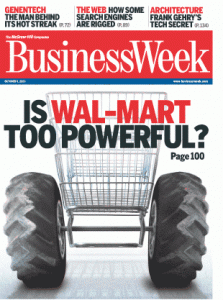 I guess our friends in Bentonville missed out again this year on making the list of 100 best places to work. No wonder, if you consider this morning’s front page New York Times piece on the giant retailer’s “bare-knuckled” tactics to ferret out any ethical transgression within the ranks of its sprawling global operation.
I guess our friends in Bentonville missed out again this year on making the list of 100 best places to work. No wonder, if you consider this morning’s front page New York Times piece on the giant retailer’s “bare-knuckled” tactics to ferret out any ethical transgression within the ranks of its sprawling global operation.
Still some members of the company’s C-suite probably enjoyed reading Michael Barbaro’s portrait of the pure and simple life inside the world’s largest retailer. The same, however, can’t be said about the portrayal of the company’s prodigious public relations operation of which we had a bare-knuckled guided tour from Jeff Goldberg in this week’s New Yorker:
“The Edelman team assigned to Wal-Mart, I learned, is divided into three groups: ‘promote,’ ‘response,’ and ‘pressure.’ The Jobs and Opportunity Zones notion came from the promotions team. The response-team members—veterans of political campaigns—are supposed to quickly counter criticism in the press or on the Web. The pressure group works on opposition research, focusing on the unions and the press.”
In his decidedly critical piece, Mr. Goldberg rehashed the company’s economic deprivation of its employees, especially part-timers, and shared in detail the often disingenuous efforts to paint the retailer as a great benefactor (a la Kim Jong II) offering lower prices to customers and economic opportunity to the un-or-underemployed. The truth even emerged about the $4 prescription gambit:
“The program has been a success, even though, so far, a relatively small number of drugs—about three hundred—are on the four-dollar list. The program is being marketed as a way for Wal-Mart to ‘give back to the community’…a ‘classic bait-and-switch,’ adding that most of the drugs on the list are older, less prescribed drugs…By applying the Wal-Mart model to the generic-drug industry—pressuring manufacturers to sell to Wal-Mart for less—Simon said, the company has been able to make ‘more money’ in pharmaceuticals ‘than we made last year.'”
This is a very complex company that clearly is internally conflicted by a desire to do good and do well. Some days the good prevails, but mostly the wells have it. While it’s admirable for such a public enterprise to seek transparency, i.e., by inviting a New Yorker reporter to peak under the kimono, I’m mystified by the decision to publicize, of all things, the PR operation.
What possible benefit can Wal-Mart have derived from shining a spotlight on what it receives for its “$10 million” PR fee? This was one story request that should have been declined — unless you can give me an example, outside of a trade publication, where the machinations of a PR team were portrayed in a positive light, let alone one embroiled in a highly contentious business and labor environment.